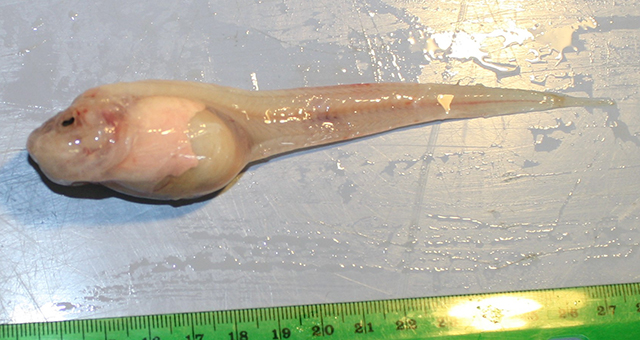| Liparidae (Snailfishes) |
| 22.6 cm SL (male/unsexed) |
|
bathydemersal; marine; depth range 6198 - 8143 m |
| Western Central Pacific: Mariana Trench. |
|
Dorsal soft rays (total): 51-58. This species possess the following characters together with its congeners: with a well-developed disk and a pair of nostrils; no pseudobranchia and pleural ribs; four radials in the pectoral girdle, which has neither notches nor fenestrae; hypural plate divided by a distal slit; a moderately well-developed disk (easily damaged in collection). It is distinguished from the two other known Pseudoliparis species by the following: differs from P. belyaevi by having a distinct lower pectoral-fin lobe (but similar to that seen in P. amblystomopsis); differs from P. amblystomopsis in having more dorsal-fin rays 55 (51-58) [vs. 49 (49-52)], more anal-fin rays 48 (43-49) [(vs. 43 (42-45)], more vertebrae 61 (56-62) [vs. 55-57], although these ranges somewhat overlap; differs P. amblystomopsis in having shorter head length, 17.0-21.7 %SL (vs. 21.6-24.0 %SL) (Ref. 116641). |
| This species was reported to be abundant at depths of ca. 7,000-8,000 m and video records showed large aggregations of different-sized individuals attracted to the bait (mackerel) and fed on swarms of amphipods. Smaller individuals were caught at greater depths and no individuals were seen at depths below 8,200 m, which is apparently the physiological depth limit for teleosts. Ripe females had eggs up to 9.4 mm in diameter, among the largest teleost eggs recorded; 0.4 mm smaller than the largest record. Eggs were unsorted within gonad, with the largest eggs free and interspersed within a matrix of smaller eggs. No developmental structures were visible within even the largest eggs. Two distinct size classes of eggs present with up to 23 large eggs (>5 mm) and up to 851 small eggs of less than half the diameter of the larger size class; rarely in intermediate stages. Individuals with only small eggs had maximum egg sizes ranging from 0.7 to 1.4 mm. Genital papilla is visible in freshly collected males, and is oriented anteriorly (Ref. 116641).
.
A self-powered robot that can dive into the ocean's deepest trench was largely inspired by the bones in the skull of P. swirae (Ref. 124589). |
|
Not Evaluated (N.E.) Ref. (130435)
|
| harmless |
Source and more info: www.fishbase.org. For personal, classroom, and other internal use only. Not for publication.

